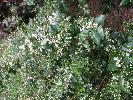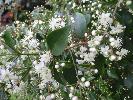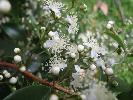Species profile—Decaspermum struckoilicum (Mount Morgan myrtle)
Classification
Plantae (plants) → Equisetopsida (land plants) → Myrtaceae → Decaspermum struckoilicum (Mount Morgan myrtle)
Sighting data
Species details
- Kingdom
- Plantae (plants)
- Class
- Equisetopsida (land plants)
- Family
- Myrtaceae
- Scientific name
- Decaspermum struckoilicum N.Snow & Guymer
- Common name
- Mount Morgan myrtle
- WildNet taxon ID
- 27465
- Nature Conservation Act 1992 (NCA) status
- CR
- Environment Protection and Biodiversity Conservation Act 1999 (EPBC) status
- Critically endangered
- Conservation significant
- Yes
- Confidential
- No
- Endemicity
- Native
- Pest status
- Nil
- Short Notes
- BRI 429036 (Holotype), 429037 (Isotype)
- Description
- Decaspermum struckoilicum is an erect multi-stemmed shrub or small tree growing up to 5 m tall. The bark is smooth to somewhat flaky, grey or brown. The branchlets of the current year are round, grey to reddish brown, smooth, sparsely short sericeous, with indistinct oil glands. The leaves are discolorous, matte or slightly glossy above, matte below, decussate, opposite, usually evenly distributed along the branches and coriaceous. The upper and lower leaf surface is glabrous and the oils glands are prominent. The leaves are elliptic in shape, pinnately nerved, 18 to 55 mm long and 10 to 35 mm wide. The base of the leaf is cuneate, the apex acute, the uppermost tip is pointed to mucronate and the margins are flat. The leaf axils bear 2 to several setose, ferrugineous hairs. The petioles are glabrous to sparsely sericeous, 1.5 to 4.5 mm long, glandular when young and becoming somewhat rugulose with age. The petioles are olive-green to reddish in colour and smooth to channelled above.
The inflorescence is terminal or axillary, solitary or paired, paniculate, with anthopodia occasionally present. Peduncles are rigid, 2.5 to 4.5 mm long and subtend each flower. There are 2 bracteoles, linear to narrowly triangular, 1.0 to 1.4 mm long by 0.3 to 0.5 mm wide, ascending to erect. There are 4 or 5 yellowish white petals, which are glabrous to minutely ciliate, glabrous below, widely ovate to oblate in shape, 3.0 to 3.5 mm long by 2.5 to 3.5 mm wide. There are 16 to 25 stamens which occur in 1 to 3 whorls. The fruit is a soft glabrous, dark, bluish-black berry, subglobose to globose with a rounded base, up to 7.5 mm long and 8.5 mm wide. There are up to 8 seeds in mature fruits, which are rounded to somewhat reniform, flattened, dark, 2.2 to 3.7 mm long.
Decaspermum struckoilicum is similar to Decaspermum humile, however it differs in the smaller, ovate, acute leaves and the shorter petioles (Snow and Guymer, 2001). - Map
- View Map
- Distribution
- Decaspermum struckoilicum is known from five localities, about 8 km east of Mount Morgan, Queensland, in the area known as Struck Oil (Queensland Herbarium, 2012). It occurs in Bouldercombe Gorge Nature Reserve.
- Distributional limits
- -23.6177777, 150.4607278
-23.6408194, 150.465 - Range derivation
- Range derived from extent of the taxon's verified records
- Habitat
- Decaspermum struckoilicum occurs in semi-evergreen vine thickets on reddish or chocolate soils, often in disturbed areas and at elevations up to 300 m (Snow and Guymer, 2001; Queensland Herbarium, 2012).
- Reproduction
- Flowering of Decaspermum struckoilicum has been recorded in October and November and fruiting from November through to February (Snow and Guymer, 2001; Queensland Herbarium, 2012).
- Threatening processes
- The main identified threat to Decaspermum struckoilicum is weed incursion, particularly by Lantana camara, Megathyrsus maximus and Cryptostegia grandiflora. The main potential threats to D. struckoilicum include wildfire from adjoining sclerophyll forests, and habitat disturbance from domestic stock (DSEWPC, 2012).
- Status notes
- Decaspermum struckoilicum is listed as Endangered under the Environment and Biodiversity Conservation Act 1999 and Endangered under the Queensland Nature Conservation Act 1992.
- Management documents
- Department of Sustainability, Environment, Water, Population and Communities (DSEWPC) (2012). Decaspermum struckoilicum in Species Profile and Threats Database, Department of Sustainability, Environment, Water, Population and Communities, Canberra. Available from: http://www.environment.gov.au/sprat. Accessed Wed, 14 Mar 2012 14:43:11 +1100.
- Management recommendations
- Regional and local priority actions to support the recovery of Decaspermum struckoilicum are outlined by DSEWPC (2012). A summary of these include: avoid habitat loss, disturbance and modification (e.g. monitor the progress of recovery, including the effectiveness of management actions and the need to adapt them, minimise adverse impacts from land use at known sites; investigate formal conservation arrangements); control invasive weeds (implement management plans for Lantana and Rubber Vine and develop strategy for Guinea Grass; manage sites to prevent the introduction of invasive weeds); minimise trampling, browsing and grazing (e.g. where livestock grazing occurs use an appropriate management regime); manage fire (e.g. develop and implement a suitable fire management strategy for D. struckoilicum); increase conservation information (raise awareness of D. struckoilicum within the local community) and enable recovery of additional sites and/or populations (e.g. undertake appropriate seed collection and storage).
- References
- Department of Sustainability, Environment, Water, Population and Communities (DSEWPC) (2012). Decaspermum struckoilicum in Species Profile and Threats Database, Department of Sustainability, Environment, Water, Population and Communities, Canberra. Accessed 14/03/2012. http://www.environment.gov.au/sprat.
Queensland Herbarium (2012). Specimen label information. Queensland Herbarium. Accessed 14/03/2012.
Snow, N. and Guymer, G.P. (2001). A new and endangered species of Decaspermum (Myrtaceae) from east-central Queensland. Novon 11 (4): 475-477. - Profile author
- Lynise Wearne (12/03/2012)
Other resources
- Species Profile and Threats Database (SPRAT)
- The Australasian Virtual Herbarium (AVH)
- Atlas of Living Australia
Data source
This profile data is sourced from the QLD Wildlife Data API using the Get species by ID function used under CC-By 4.0.
https://apps.des.qld.gov.au/species/?op=getspeciesbyid&taxonid=27465.
This information is sourced from the WildNet database managed by the Queensland Department of Environment and Science.





